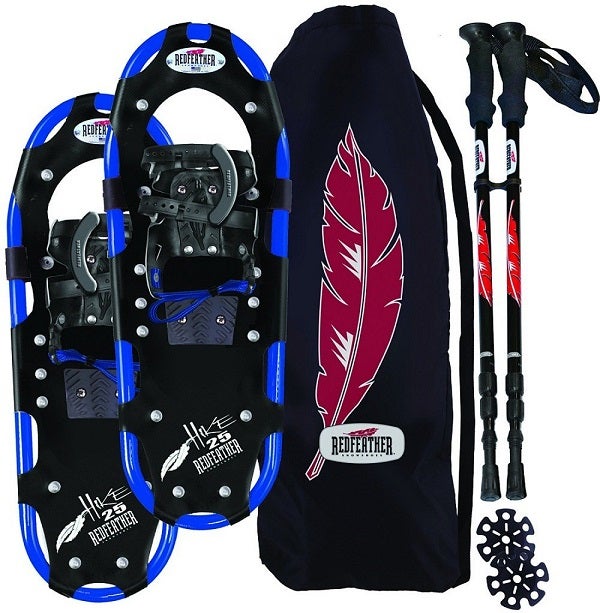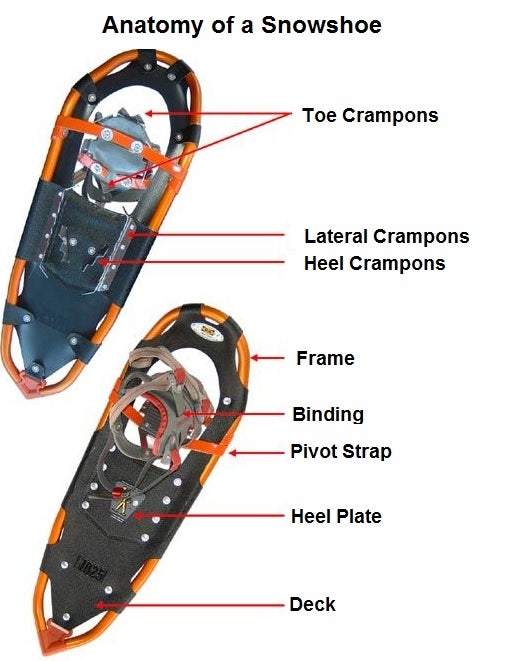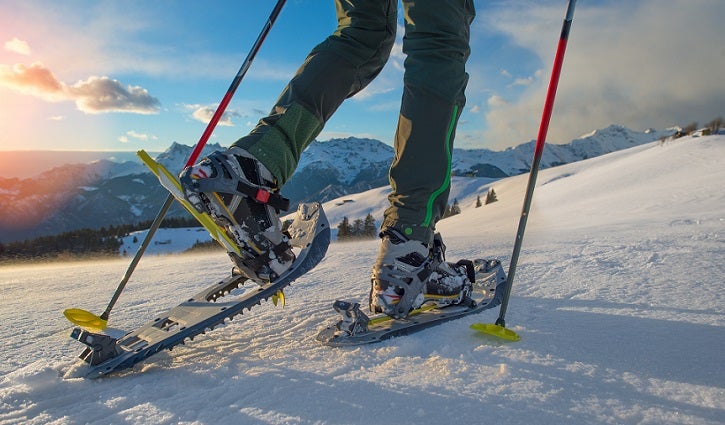
Our Editors independently research, test, and rate what we feel are the best products. We use affiliate links and may receive a small commission on purchases.
Just because it’s winter doesn’t mean you should give up hiking or trail running. I think snowshoeing is a better workout, and there is something about being in the woods in the winter that is hard to describe. You probably already have the winter apparel, now you just need a pair of the best snowshoes and you don’t need to spend a lot of money. But how do you know which ones are right for you? There are quite few to choose from. Where there is a Women’s model snowshoe available, a link is provided. Let’s get to it!
The Best Snowshoes For Winter Adventures
For more of my winter gear recommendations, have a look through these popular Outside Pursuits guide links: Snowshoe Boots, Heated Socks, Hand Warmers, Base Layers.
Quick Answer: The Best Rated Snowshoes
- MSR Evo Trail Hiking Snowshoes
- Chinook Trekker Snowshoes
- Atlas Helium BC Unisex Snowshoes
- Tubbs Flex Alp
- RedFeather HIKE Recreational Series
- Winterial Snowshoes
Our reviews of the top rated snowshoes with our comparison table and buyers guide will help you choose the right pair of snowshoes.
Snowshoe Reviews
#1 MSR Evo Trail Hiking Snowshoes
- Size: 22-Inch (optional Tails available)
- Weight Capacity: Up to 180 Pounds with Optional tails 250 Pounds
- Weight: 3 lbs 9 oz
- Construction: Steel Frame, Plastic Deck
MSR, a highly reputable brand owned by Cascade Designs is probably best known for their camping gear.
Immediately inspiring confidence, we learn that the traction components of these snowshoes are made of steel. What’s more, they’re molded directly into the body of the snowshoe – this leaves little room for components to fail.
A very simple aluminum and rubber non-moving-parts binding system says to me that MSR intended to mechanically simplify this snowshoe to increase user experience and decrease potential broken parts.
Modular and adjustable tails for these snowshoes mean adjustability when the snow gets deep and I think it’s a feature which greatly improved the value of the snowshoe as a whole.
In my opinion with the tails put on, these are best snowshoes for backcountry use. However, the tails are not included and need to be purchased separately.
#2 Chinook Trekker Snowshoes
- Sizes: 19, 22, 25, 30, 36 Inches
- Weight Capacity: 90 pounds for 19 inch / Up to 300 pounds for 36 inch
- Weight: 3.91 Pounds
- Construction: Aluminum Frame / Polyethylene Decking
For a budget minded traveler the Chinook snowshoes aren’t a bad choice. Featuring plastic decking and full rotation bindings, these snowshoes are middle of the road. Aluminum frame is lightweight and durable but not top of the line.
With aluminum crampons the durability won’t be world-class but it’s a long shot better than plastic teeth on your crampons. Don’t traverse a bunch of rock or you’ll have worn out crampons in no time.
The heel spikes on the crampons certainly come in handy for downhill travel.
Even at such a bargain price they included carrying bag which is a nice feature although far from a deciding factor in my mind.
I generally would say that even at such a bargain price you can have confidence in this entry-priced pair of snowshoes.
The Chinook Trekker’s are probably the best snowshoes for the money.
#3 Atlas Helium BC Unisex Snowshoes
- Sizes: 24, 28 Inches
- Weight Capacity: 270 pounds for 28 inch
- Weight: 4.9 Pounds
- Construction: Composite V Frame / PVC-free Composite Decking
The Atlas Snowshoe Company was formed over 25 years ago by Perry Klebahn and Jim Klingbeil. They were both avid snowshoers and unhappy with current snowshoe technology and decided they could do better.
Their first snowshoe broke ground with a new innovation called a “Spring Loaded Suspension” that kept the snowshoe close underfoot for easy maneuvering. To this day, Atlas only makes snowshoes and accessories.
They have designed the Helium’s frame so that it uses an elliptical shape in the areas of the shoe with the greatest loads instead of the typical round shape all the way around. This creates a stiffer and stronger frame.
I also like that Atlas included a heel bar, this aids greatly in reducing fatigue when climbing steep inclines.
The Helium uses their original patented SLS or Spring Loaded Suspension design that keeps the snowshoe close to your foot to decrease fatigue and allow for better maneuverability, especially on steep inclines.
The crampons use stainless steel for excellent traction on ice and frozen, hard terrain.
Atlas designed the Helium’s suspension and rails to be able to allow the bindings, crampons and frame to all articulate independently to allow you to hike through deep, soft snow and rough surfaces.
These snowshoes are also designed for packability, the bindings can fold flat to fit better in your backpack. These are an excellent choice for backcountry use and I think the best snowshoes for deep snow.
#4 Tubbs Men’s Flex Alp
- Sizes: 24, 28 Inches
- Weight Capacity: 220 pounds for 28 inch
- Weight: 5.3 Pounds
- Construction: Unibody Aircraft Grade Aluminum Frame
Tubbs Snowshoes was founded over 100 years ago in Norway, Maine and was one of the first companies to make snowshoes specifically designed for women.
Tubbs has since moved to Washington in the shadow of Mt Rainer and continue their excellence in snowshoe design.
The Flex Alp 24 have been designed for backcountry use with light carbon steel crampons and teeth designed to give excellent traction. Tubbs has a unique curved design on the rails for traction on the side of hills or hard, icy conditions.
I really like the tail design on the Flex Alps, you will find them easier to walk with because they absorb heel shock reducing stress on your ankles and knees.
The Flex Alp 24 has a similar design to the Atlas Snowshoes in that they allow articulation throughout the shoe giving you good traction in rough and uneven surfaces while being more comfortable and reducing fatigue.
Video: Feature overview of the Tubbs Atlas Snowshoes.
I think Flex Alp snowshoes are more appropriate for unpacked snow vs groomed trails. If you plan on hiking mostly groomed trails, there are better options (like the MSR Evo or Redfeather Hike).
With the superior shock absorption of the the Tubbs Flex Alps, I think these are the best snowshoes for seniors.
#5 RedFeather HIKE Recreational Snowshoe Kit Review
- Sizes: 22, 25, 30, 36 Inches
- Weight Capacity: 22 inch / 160 lbs and Up to 250 pounds for 36 inch
- Weight: 3 lbs 5 oz
- Construction: 6000 Series Aluminum Frame / TX 35 Rip Stop Nylon
RedFeather not as well known for snowshoes as other brands, is owned by ORC Industries. ORC is a not for profit company whose sole purpose is to employ people with disabilities.
They are hand crafted in La Crosse, Wisconsin so if you buy from them you can feel good you are helping out worthy cause.
That of course it not the main reason for buying the RedFeathers. The reason is these snowshoes are lightweight, strong and provide good traction.
The lightweight series 7200 aluminum makes for a strong frame coupled with decking of TX 35 rip stop polymer that maintains its softness at below zero temperatures.
The “sure grip” crampons made from stainless steel provide excellent stability and strength.
They have an anti-shock mechanism to reduce stress on your joints for all day hiking comfort and there is a “live action” hinge that lifts the tail of the snowshoes for every step so it doesn’t drag for added hiking speed.
The RedFeather snowshoe set includes adjustable poles that the snow baskets are removable so you can use them for hiking and the set is completed with a carry case.
It’s nice to know not only are you getting a good set of snowshoes but you can feel good about helping a worthy cause! For the ladies, the RedFeather makes what may be the best women’s snowshoes.
Women’s Model: RedFeather Women’s HIKE Recreational Series Snowshoe
#6 Winterial Snowshoes
- Sizes: 18, 25, 30 Inches
- Weight Capacity: Up to 240 Pounds
- Weight: 4.4 Pounds
- Construction: 6000 Series Aluminum Frame / Lightweight Nytex Decking
Despite the fact that the Winterial Snowshoes comes with an included pair of hiking poles I am actually going to mark that as a negative.
As a long time outdoor professional I know that a huge majority of outdoor enthusiasts already own a pair of poles which are probably higher quality, lighter weight, and more well suited to the individual.
Now if you don’t already have a pair then this will save you some money. The poles are pretty good and fully adjustable.
I have to admit that my confidence was not inspired by the quickly assembled look or large use of aluminum and plastic components which are more common in lower end snowshoes.
Pay attention to choosing the right size when you commit to this snowshoe as they seem to be offered in sporadic intervals. Double check with the sizing chart on Amazon so that you’re getting the right size.
They are offered in quite a variety of style and colors. So you should be able to find a pair not only for men and women but also for children.
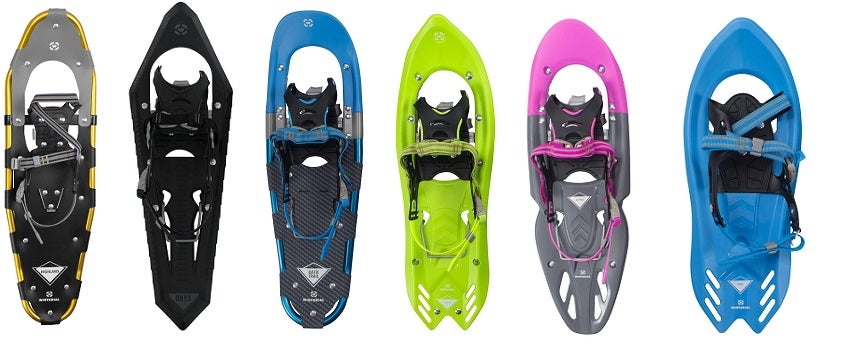
I’d really like to see more attention to the rivets used to secure the decking to frame. However even after several seasons of use, they still are holding up just fine.
Like most budget minded people I don’t like paying more for gear than I have to. With the Winterial Snowshoes you get a good pair at a very reasonable price.
In my opinion these are the best snowshoes for beginners because they come with everything you need to get out on the trails.
Snowshoes Comparison Table
| Snowshoe | Sizes | Max Weight | Shoe Weight | Frame | |
|---|---|---|---|---|---|
| MSR Evo Hiking Snowshoe | 22-inch (optional Tails available) | 180 lbs with tails: 250 lbs | 3.7 lbs | Unibody Steel | |
| Chinook Trekker Snowshoes | 19, 22, 25, 30, 36 inches | 36" - 300 lbs | 3.9 lbs | Aluminum | |
| Atlas Helium BC | 24, 28 inches | 28" - 270 lbs | 4.8 lbs | Composite V | |
| Tubbs Flex Alp | 24, 28 inches | 28" - 220 lbs | 5.3 lbs | Unibody Aluminum | |
| RedFeather HIKE Recreational | 22, 25, 30, 36 inches | 36" - 250 lbs | 3.3 lbs | 6000 Series Aluminum | |
| Winterial Snowshoes | 21, 25, 27, 30 inches | 30 " - 255 lbs | 4.8 lbs | 6000 Series Aluminum |
Author’s Expertise / Why You Should Trust Our Reviews
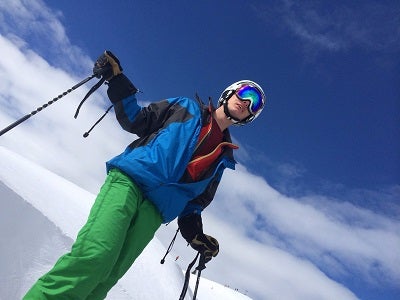
I started writing online for my own outdoor sports blog in 2010. Right out of the gate I landed opportunities to test gear for Road ID, Hydrapak, Wolverine, Helle Knives, Pearl Izumi, and GU Energy. Those were the days when growing a no-name blog was easy. Today niche blogging is a different story.
In 2012 I left Central Wyoming College with a degree in Outdoor Education and Leadership. Soon after, I was on a month-long expedition with the National Outdoor Leadership School’s Outdoor Educator Course which helps would-be outdoor guides ascend from “aspiring” to “inspiring”.
Between here and there I’ve participated in and spoken at length about outdoor pro-deal programs for companies like Patagonia, Smith Optics, Giro, Therm-a-Rest, Platypus, MSR, Columbia, and many more. I still work closely with tons of outdoor gear companies to review and analyze products. If you have a product opportunity you’d like to discuss, please review my guidelines and contact me here.
After several seasons of guiding backpacking trips and working as a certified Alpine Ski Instructor at Deer Valley Resort in Park City, UT for several seasons, I had to move on. As any educator will tell you – teaching doesn’t pay the bills very well.
In 2016 I began building my freelance writing career as readers and other bloggers reached out to me for help with technical outdoor sports content strategy for online businesses. Within weeks I was overloaded with requests for freelance writing and my new career blossomed.
2018 saw the launch of Hike With Less, my ultralight backpacking partnership program with Dustin Walker.
How to Choose the Best Snowshoes
- Why You May Need Snowshoes
- What to Look for in Snowshoes
- Traction
- Harness Attachment and Bindings
- Testing Your Bindings
- Heel Lift
- Floatation
- How to Properly Size a Snowshoe
- FAQs For Snowshoes
- Best Snowshoe Brands
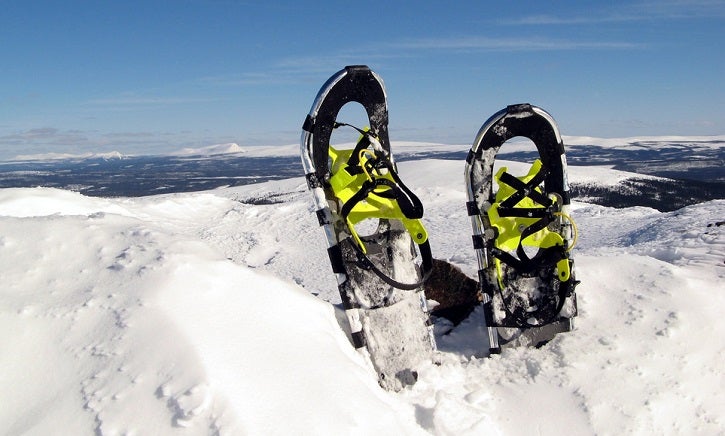
When I bought my first pair of snowshoes, I found a used pair on the cheap from the local Craigslist scene. I took them out in the first snowstorm we had and they summarily broke within minutes.
Somehow I convinced the guy to give me my money back for his crappy old snowshoes but the point was clear – I had no idea what I was buying.
Learning what makes a pair of snowshoes a good choice for your needs is critical in avoiding dumb purchasing decisions like mine. While seemingly a simple tool, snowshoes warrant a fair amount of understanding and consideration in purchasing.
Let’s take a look at some of the most critical criteria for evaluating a snowshoe purchase and why to bother buying a pair in the first place!
Why You May Need Snowshoes
Traveling during snowy weather really leaves you two main options (unless you have a dog sled). You can ski or snowshoe. Each of these traveling methods is a topic unto its own but for not we’ll just highlight some benefits of each:
Skiing
- Faster on flat sections and downhills
- Sometimes floats better in soft or deep snow
- Skis can be used to create your shelter
Snowshoeing
- Easier to traverse densely cluttered areas
- Easier on uphill travel
- Can traverse ice more readily
If you’re not going to use snowshoes or skis, you’re really left with boot packing it in the snow which is no fun at all and leads to sore, tired legs and wet, frustrated people.
Snowshoes are really not needed outside of knee deep snow conditions. Short travel in snow ankle deep is easier done in good boots. Once the snow piles up to mid-calf or knee deep then you’d better have a pair of snowshoes!
Video: How to choose snowshoes from REI.
Snowshoe Footwear
You’ll want to pair a good set of snowshoes with a nice pair of winter boots or hiking boots. I would recommend finding your winter travel footwear first and then choosing a snowshoe to be certain the snowshoe will fit your boot appropriately.
Hiking Boots
I hate hiking boots, they have many serious drawbacks for real hiking but they might just hit their stride for winter snowshoeing.
You’ll have to decide how important waterproof boots are to you and where you’re going. For winter snowshoeing I would say waterproof boots are definitely a worthy consideration. See my recommendations for snowshoe boots here.
Winter Snow Boots
The majority of “winter boots” are really not made in a way which is conducive to backcountry travel. Often the liners are absurdly thick and warm and not removable. This means once they get wet with sweat, they’ll stay that way.
This type of footwear is also just notorious for poor quality and fashion over function. Be selective here.
Mountaineering Boots
If you need mountaineering boots, you’ll probably already know it by now. The casual outdoor enthusiast does not need mountaineering boots.
If you’re planning a trip up Denali, you might consider it. If you’re planning a trip to the local resort, you definitely don’t need them.
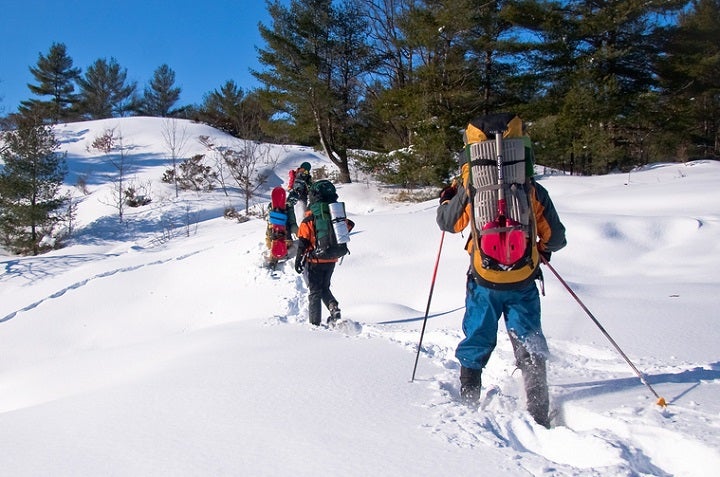
How to Choose Snowshoes
Snowshoes come in several flavors but we’re going to keep it narrowed down to three main flavors:
- Recreational & Budget
- Backcountry Travel
- Running
Recreational & Budget Snowshoes
The recreational snowshoe would most commonly be used the beginner snowshoer who is going to use them on mostly flat terrain, on mostly either groomed park trails or packed snow.
This type of shoe does not need the best traction and stability just be comfortable and secure on the foot. The Chinook Trekker Snowshoes and the MTN All Terrain Snowshoes are perfect for this type of snowshoer.
Backcountry Travel Snowshoes
The snowshoer going into the backcountry will need an entirely different type of snowshoe. The person heading into the backcountry in the mountain valleys, and remote untraveled areas needs a snowshoe with excellent traction, durable construction, secure bindings and as lightweight as possible.
Heading into the backcountry will be significantly more advanced than the groomed trails in a park area. The backcountry snowshoer should be aware of possible avalanches (see my beacon reviews here) and experienced in mountaineering.
The snowshoe needs an aggressive traction snowshoe with heel lifts for steep climbs. The MSR Lightning Ascent Snowshoes is an excellent snowshoe for this purpose.
Running Snowshoe
This is a very specific model not covered in the article. This snowshoe would be significantly smaller, lighter and a tapered tail to allow this type of activity.
There are many considerations to be made when choosing from among these two categories and once you’ve decided whether you’re a hardcore backcountry snowshoer or a weekend warrior, you’ll be ready to start looking at the following factors which affect snowshoe performance.
Traction
Not only do snowshoes need to help you float above the snow, they must also help you grip slick and sometimes icy surfaces.
During certain snow conditions a hard and thick layer of ice can form on the surface of the snow (known as “crust”).
This layer can often support body weight and if your snowshoes don’t have some manner of traction on the bottom, you’ll be sliding around like Bambi on the pond.
Traction methods usually involve jagged metal teeth under the foot area of the snowshoe or (sometimes both) along the outer edge of the snowshoe frame.
Carefully assess the likelihood of your need for traction when traveling with snowshoes before deciding what is right for you.
The more aggressive and steep the terrain you’ll be traveling as well as the likelihood of needing ice traction will determine your level of need for traction components and crampon type systems.
In mountaineering type settings you may need some advanced level traction systems.
Watch out for traction systems featuring plastic components or plastic teeth. These weaker materials are guaranteed to fail.
Harness Attachment and Bindings
Snowshoes have to attach to your boots somehow. This is usually a system of straps and buckles which wrap over your boot and keep the snowshoe stuck fast against your foot.
These systems can be fickle at times and often feature weak plastic components when buying budget-category snowshoes.
Bindings which feature a ratchet-style closure offer the best fitment and security in our opinion and we suggest you seek these whenever possible.
It is worth noting that some snowshoe bindings allow the snowshoe to rotate freely and limitless. These are full rotation bindings and may cause extra drag by allowing the tail of the snowshoe to drag along the snow behind you with each step.
The other type of binding is slightly more efficient and is called a fixed rotation binding – that is the snowshoe is held fast by the binding after a certain point and won’t be able to drag along behind you when you pick your foot up past a certain level.
Generally speaking fixed rotation bindings are a solid choice for the every day snowshoe enthusiast.
Testing Your Bindings
Remember to use the boots you’ll be traveling in when testing snowshoes. Try getting in and out of your snowshoes with gloves on and operate the binding systems to see how easy they are to use.
Test how snugly the binding fits your boot by checking for lateral and fore-aft slipping.
If you’re sensing a hot spot or pressure point where the straps of the bindings pinch your foot, that’s absolutely a no-go – you must solve this problem before traveling or you will pay the price with blisters.
Heel Lift
Much like backcountry ski bindings, some snowshoes feature a heel lift which can be adjusted to the angle of the slope which you are climbing.
If you’re going to be climbing with your snowshoes this is recommended as it allows your foot to stay more level as the slope becomes increasingly aggressive.
For flat land walking, a heel lift is not really necessary.
Floatation
The float offered by a snowshoe is measured by the surface area of the decking (the part underfoot which presses against the snow).
More decking and a bigger snowshoe means more float. This is important if you are heavy, tall, or entering areas with deeper or softer snow.
Some snowshoe offer clip-on style additions which increase overall snow contact surface area and boost floatation. Consider a modular system like this if you expect to enter varying snow conditions and deep powder frequently.
How to Properly Size a Snowshoe
Sizing is really all about surface area versus weight. While we will talk about a few other considerations, this is really the deciding factor.
The heavier you are, the more surface area you will need in your snowshoe to distribute your weight so you don’t sink in the snow. This is pretty basic physics.
Snowshoe size depends on many factors:
Go bigger if:
- You (and your carried gear) weigh more
- The snow is deep
- The snow is soft (recent deep powder dumps)
- You’re walking in open areas
Go smaller if:
- It’s just you (no backpack or heavy gear)
- The snow pack is thin
- The snow has had time to set up
- You’re hiking groomed snow trails
- You’re walking in tight areas (through trees, brush, etc.)
The more dense or packed down the snow is, the less floatation you’ll need for a given weight.
Every snowshoe manufacturer should have a sizing guide on their products. Refer to this sizing guide and don’t forget to include the weight of your gear and pack in your calculations.
There’s no way for me to tell you exactly what size you need. If you’re still in doubt go rent some snowshoes this winter and try them out. Make note of what size they are and how they worked for you!
Gender
Snowshoes can often be found in gender variations. This is not a sales gimmick – there’s really a difference.
Probably the most important difference is hip width and stride dynamics. Men and women are just built differently and this affects our stance and stride.
Be sure to take into consideration your needs when choosing a snowshoe as it may be prudent to purchase a gender-specific snowshoe.
Snowshoe Poles
Absolutely a necessity in my book, hiking poles are critical to enjoying snowshoeing.
PRO TIP: Make sure your hiking poles feature a powder basket for snow. Powder baskets are larger and spread out the force of your hiking pole across the snow, in much the same manner as your snowshoe.
This prevents you from plunging your hiking pole uselessly into the snow. Avoid the gimmicky cheap three-piece rotation lock hiking poles.
They’re heavier than packing the kitchen sink. Look for fixed length hiking poles with a powder basket option and save yourself some problems.
FAQs For Snowshoes
Q: Can I make my own snowshoes?
A: Yeah, you totally can! Actually there are several companies that will send you snowshoe kits and you can lace your own traditional wooden snowshoes!
Don’t worry, they’re pretty affordable and it’s a fun process. They’re totally functional and not just wall hangers.
This is actually a great holiday gift idea for the outdoor lover in your family.
Q: Do I need crampons on my snowshoes?
A: Those handy backward facing metal spikes on snowshoes are there to save your butt from a nasty fall. You definitely need them!
With few exceptions metal crampons on the bottom of your snowshoes are handy for gaining grip on ice and hard-packed snow.
The only time you really don’t need them is if you’re hiking pure bottomless pow (as the kids say). Some snowhoes have removable crampons so consider that if you want more adaptability.
Q: How can I identify poor quality snowshoes?
A: You’re a discerning consumer, eh? Not just a mindless sheep of the masses, you say? Here’s how you can tell if your snowshoes are worth a crap.
One of the most common construction methods for modern snowshoes is the pop rivet. These handy little doo-dads make factory assembly fast and easy but they’re not always the highest quality. In fact, pop rivets are probably solely responsible for 70% of snowshoe failure (in my experience).
Look for pop rivets that are not fully set. They might be sitting at a wonky angle, not fully inserted, or beginning to take damage. Especially where the decking attaches to the frame, make sure the rivets there are holding up well and look cleanly assembled from the factory.
If you need to make repairs and haven’t worked with rivets before check out this video on repairing snowshoes.
Q: Are plastic snowshoes cheaply made?
A: They can be, but rarely have I seen them fail. In fact, plastic snowshoes might be my personal favorite because they seem to be almost indestructible.
Because they’re made from one single piece of molded plastic, these snowshoes don’t have very many joints or moving parts to break.
Best Brands of Snowshoes
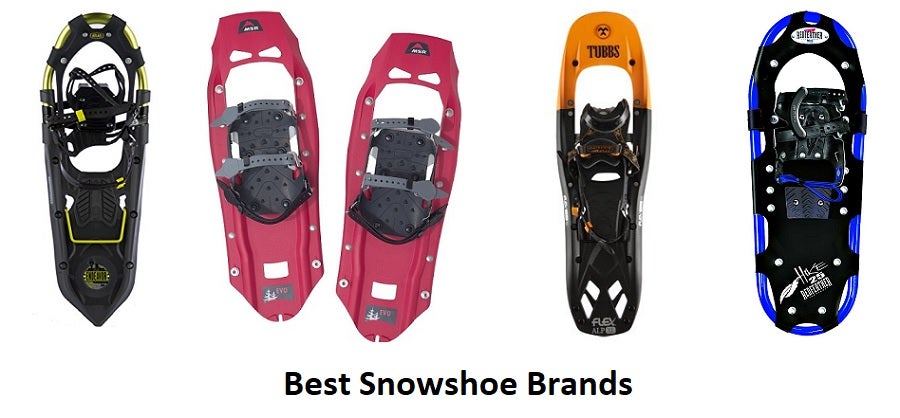 There are several brands of snowshoes on the market I feel are worth your consideration. Lets take a look at them now:
There are several brands of snowshoes on the market I feel are worth your consideration. Lets take a look at them now:
MSR: Formed in the late 60’s they have grown into a global brand of outdoor equipment.
Atlas Snowshoe Company: Formed by avid snowshoer Perry Klebahn, they pioneered the “spring loaded” snowshoe for easier walking up hills.
Redfeather: Another company focused solely on snowshoes, they make their snowshoes in the USA in Wisconsin.
Tubbs: Making quality snowshoes for over 100 years now, the Flex Alp’s are a great option.
Conclusion
You’ll get what you pay for with snowshoes and the overabundance of plastic components and cheap quality aluminum construction in many budget snowshoes lacks confidence.
I would recommend the MSR EVO 22 without a doubt for its quality and reputation.
Don’t forget to do your research and shop around before committing to the best snowshoe option for you. Seek a shoe which is comfortable, sized appropriately, and ready to meet your needs.
How We Researched
To come up with the top snowshoes we researched a variety of sources for reviews such as REI, Backcountry, Moosejaw, EVO along with our own personal experience.
We also consulted online magazines for product research and reviews to get as much unbiased information as we could. To help weed out fake reviews we used Fakespot.com to make sure we only looked at genuine reviews.
With so much quality gear available, we had to narrow it down based on what we felt were the best options were for the price. The author, Casey Fiedler was a full time ski instructor for Park City and The Canyons in Utah.
To help narrow down the selection he used his personal experience along with recommendations from backpacking guides.
After extensive research, we came up with our list to help you choose the right pair for you.
Sources
I hope this guide was helpful for finding the best snowshoes to fit your needs. If you want to comment or recommend a pair of snowshoes I didn’t include, please use my contact form to get in touch.
New to snowshoeing? Read my Beginners Guide to Snowshoeing for tips and advice.
Have fun and enjoy your hike!

